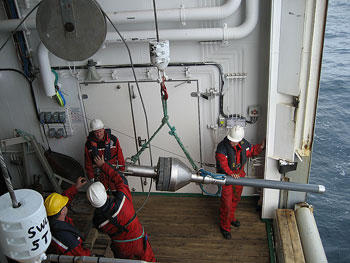Day 5 - 29 June
We have arrived at our first station. Everyone was on hand to watch the first CTD go down. It is equipped with three extra sensors brought by geochemical expert, Eric Olson from the University of Washington.
Main content
Position: 71N 05W
Temperature: 2.4 (air), 4.0 (water)
Wind speed: 6.4m/s
Wave height: 5.8 (max)
Visibility: fair
Weather: overcast
The first station is one of the hydrothermal vents identified in 2005. Returning to a known site will make it possible to calibrate the sensors so that researchers can better identify hydrothermal vent areas in unexplored parts of the mid-ocean ridges heading north and west from here.
We are also going to do some gravity coring. Although the corer can reach up to 4m or so into the sediments. Rolf Pedersen explains that the seafloor here has relatively little sediment cover, and that we will be lucky to get cores as long as 1m.
Sediment cores are important for getting a historical picture of an area. Researchers hope to be able to distinguish distinct layers that will provide information about the hydrothermal activity in the area. Debris in each layer will also provide information about the distribution of fauna in the region over time.
Researchers will also collect fluid samples with the CTD. Their analysis will provide valuable information and identifying characteristics for future vent exploration.
Unfortunately there have been a number of setbacks. The ROV has had a technical set-back. The ROV crew is working around the clock to put it to rights. Everyone has their fingers crossed that they will be successful. Also, the CTD performed poorly with some of the bottles not opening and others opening prematurely. Finally the gravity corer had disappointing results. After three tries, it confirmed that the bottom was very rocky and covered by almost no sediments.
We are now heading north towards Svalbard. Helge will be mapping as we go.
